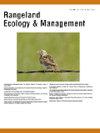牛利用河岸的建模——管理、季节和天气的影响
IF 2.4
3区 环境科学与生态学
Q2 ECOLOGY
引用次数: 0
摘要
由于河岸生态系统因其多样化的生态服务而受到高度重视,过去和现在对河岸地带的干扰已经导致了广泛的恢复努力、诉讼和对牲畜放牧影响的合规监测。更好地了解影响牛河岸利用的因素,特别是在支持受威胁或濒危鱼类的景观中,可以改善对可持续放牧系统的管理结果和河岸恢复的预测。虽然已发表的模型预测了牛对栖息地的选择,但我们对牛在河岸地带的使用或占用的理解存在差距。作为美国俄勒冈州半干旱河岸系统长期多学科项目的一部分,我们收集了4年(2017-2020)的牛遥测数据,以确定影响牛利用河岸的因素。我们在贝叶斯层次框架中使用β回归模型来模拟河岸带牛的日分布比例。我们假设河岸的利用会随着儒略日、温度、太阳辐射、放牧天数和放牧后天数的增加而增加,而随着湿度和降水的增加而减少。最佳模型预测,随着放牧天数、放牧天数和儒略历的增加,牧草的利用程度越大,相对湿度的增加则越低。牛在不同年份和牧场的日河岸利用平均为0.167(标准差 = 0.180)。最终模型表现良好,基于k-fold交叉验证(Pearson’s correlation = 0.72;90% CI从0.66到0.77)。我们的研究结果表明,考虑影响牛利用河岸的管理策略(放牧、放牧季节)与天气、牧场特征和其他因素的重要性,并可用于指导河岸放牧管理的决策支持系统。本文章由计算机程序翻译,如有差异,请以英文原文为准。
Modeling Riparian Use by Cattle – Influence of Management, Season, and Weather
Because riparian ecosystems are highly valued for their diverse ecological services, past and ongoing disturbances in riparian zones have led to extensive restoration efforts, litigation, and compliance monitoring of the effects of livestock grazing. Better understanding of the factors that influence cattle riparian use, especially in landscapes supporting threatened or endangered fish, could lead to improved predictions of management outcomes and riparian recovery for sustainable grazing systems. Although published models predict habitat selection by cattle, there is a gap in our understanding of cattle use, or occupancy, in riparian zones. As part of a long-term, multi-disciplinary project in a semi-arid riparian system in Oregon, USA, we collected 4 yr (2017-2020) of cattle telemetry data to identify factors affecting riparian use by cattle. We used beta regression in a Bayesian hierarchical framework to model the daily proportion of cattle locations in the riparian zone. We hypothesized that riparian use would 1) increase with increasing Julian date, temperature, solar radiation, days in pasture, and days since herding, and 2) decrease with higher humidity and precipitation. The best model predicted that use was greater with increasing days since herding, number of days grazing in a pasture, and Julian date, and lower as relative humidity increased. Daily riparian use by cattle averaged 0.167 (SD = 0.180) across years and pastures. The final model performed well, based on k-fold cross validation (Pearson's correlation = 0.72; 90% CI from 0.66 to 0.77). Our findings demonstrate the importance of considering management strategies (herding, grazing seasons) that affect riparian use by cattle, in tandem with weather, pasture characteristics, and other factors, and can be used in decision support systems to guide riparian grazing management.
求助全文
通过发布文献求助,成功后即可免费获取论文全文。
去求助
来源期刊

Rangeland Ecology & Management
农林科学-环境科学
CiteScore
4.60
自引率
13.00%
发文量
87
审稿时长
12-24 weeks
期刊介绍:
Rangeland Ecology & Management publishes all topics-including ecology, management, socioeconomic and policy-pertaining to global rangelands. The journal''s mission is to inform academics, ecosystem managers and policy makers of science-based information to promote sound rangeland stewardship. Author submissions are published in five manuscript categories: original research papers, high-profile forum topics, concept syntheses, as well as research and technical notes.
Rangelands represent approximately 50% of the Earth''s land area and provision multiple ecosystem services for large human populations. This expansive and diverse land area functions as coupled human-ecological systems. Knowledge of both social and biophysical system components and their interactions represent the foundation for informed rangeland stewardship. Rangeland Ecology & Management uniquely integrates information from multiple system components to address current and pending challenges confronting global rangelands.
 求助内容:
求助内容: 应助结果提醒方式:
应助结果提醒方式:


